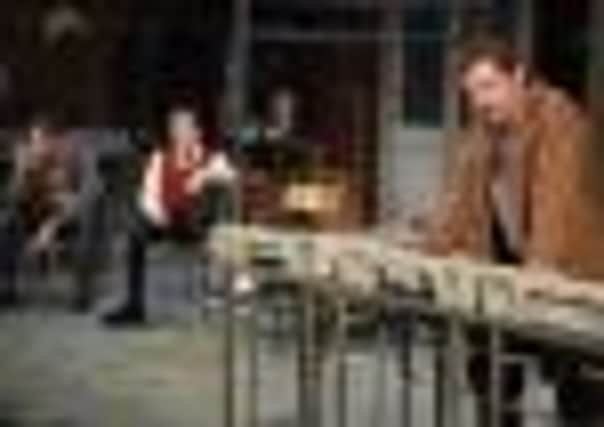Theatre review: The Mill Lavvies | Dead Famous


The Mill Lavvies
Dundee Rep
* * *
Dead Famous
Oran Mor, Glasgow
* * *
“It’s about celebrating the women of Dundee!” says the box office assistant, enthusiastically. “Yes, but is it about old Dundee?” says the woman. “Yes, it’s about women who worked in the mills while their husbands stayed at home, and they form a singing group…” “Yes, but what kind of music is it?” says the woman. “Is it the old songs?”
There’s no doubt about what you need to do, in other words, if you want to fill your theatre, in this autumn of 2012, while at the same time reaching out to audiences who are not regular theatregoers; you need to get nostalgic, and to present people from working-class communities who are now middle-aged or elderly with persuasive, non-jarring images of their trampled and officially forgotten past. For those now in their forties and fifties, the vehicle is often the tribute musical, celebrating some great band of the 1980s; but for those a little older, the sight and sound of the tenement flats and workplaces of half a century ago involves not only music, but a wealth of physical detail and language, long bulldozed by the march of history.
Advertisement
Hide AdAnd whatever else it does, Chris Rattray’s 1998 play The Mill Lavvies – premiered at Dundee Rep that year, and now revived as the first play in an autumn double-bill about working-class life in the city – fulfils to perfection the role of theatrical time-machine, transporting audiences back to an age (1963, by the sound of the Beatles songs in the air) when men were men, teddy boys were being displaced by Sixties swingers, and ordinary workers not yet 40 were still scarred by memories of military service in the Second World War.
The play is set in the men’s lavatories of a jute mill where women in their thousands work the looms, while a small male workforce carries out maintenance, and unloads the raw materials; and it invites comparison with John Byrne’s 1978 masterpiece The Slab Boys, so precisely does it mirror the same mood of tension between the older, wartime generation and teenagers sick of hearing about it, and the growing impact of popular culture and rock music on British society.
Rattray creates six vivid characters, led by Archie, the slightly daft janitor. And the show is lifted by a sequence of a dozen clever and affectionate Dundee songs by Michael Marra, for which the cast transform themselves instantly, if a little limply, into a rock’n’roll or skiffle band.
In the end, the play makes far less of this raw material than it could. The language is funny and couthy, but lacks the dash of pure, surreal poetry that makes Byrne’s vernacular Scots so memorable; all the characters except Archie are predictable, and the play struggles to create narrative tensions that will sustain it, even for a bare two hours.
Yet on Alex Lowde’s clever, super-naturalistic set – a huge barn of a space featuring toilets, washbasins and a cloakroom area, plus a huge spinning skylight ventilator through which we sense the noise and thrash of the mill – none of that seems to matter much, to the audience who pack the theatre. The point is that the play shows and celebrates, in a shared space, a popular history about which no-one else seems to care much any more; and whether or not it features the “right” music, it seems likely that the second show in the series – a new Dundee version of Sharman Macdonald’s She Town, set in the 1930s – will not fail to do the same.
There’s a strong fascination with popular culture and entertainment, too, in the first play of this autumn’s Play, Pie And Pint season at Oran Mor, which wades boldly into the world of Michael R Cane, one of those showbiz clairvoyants who claim to put suffering audience members back in touch with their departed loved ones. Cane also communes, so he says, with long-gone celebrities such as Noel Coward and Frank Sinatra, so that his show offers a tempting mix of amusing impressions and sheer emotional exploitation.
Advertisement
Hide AdIn Keith Temple’s brief half-hour drama, Charlie Ross plays Cane, presenting his solo show to an increasingly sceptical audience; in the end, after severe disruption by mysterious gremlins, the act is destroyed by the intervention of a genuine spirit voice, who knows more about Cane than he would ever wish to be revealed.
The final sequence of Temple’s play is not bad. Elsewhere, though, it seems surprisingly unsure of how to use the live audience in the theatre as part of the event; the script is short of narrative energy, and of really effective humour.
Advertisement
Hide AdAnd although Charlie Ross, as Cane, demonstrates a minor talent for impressions of the famous dead, he seems a shade uneasy with the pressures of solo performance, so that much of the show seems like a weak stand-up comedy set delivered by a nervous beginner, rather than a confident and successful clairvoyant show, crumbling under the pressure of its own contradictions.
• The Mill Lavvies runs until 29 September; Dead Famous until 8 September.